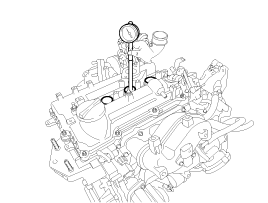Check the cylinder compression pressure.
Insert a compression gauge into the spark plug hole.

Fully open throttle.
While cranking the engine, measure the compression pressure.
Always use a fully charged battery to obtain engine speed of 200 rpm or above.
Repeat steps (1) through (3) for each cylinder.
This measurement must be taken as quickly as possible.
Compression pressure :
1,667 kPa (17.0 kg/cm², 241 psi)
Minimum pressure :
1,470 kPa (15.0 kg/cm², 213 psi)
Difference between each cylinder :
98 kPa (1.0 kg/cm², 14 psi) or less
If the cylinder compression in 1 or more cylinders is low, pour a small amount of engine oil into the cylinder through the spark plug hole and repeat steps 1) through 3) for cylinders with low compression.
If adding oil helps the compression, it is likely that the piston rings and/or cylinder bore are worn or damaged.
If pressure stays low, a valve may be sticking, seating is improper, or there may be leakage past the gasket.
